1. Spring 对 Junit4,Junit5 的支持上的运用
文章目录
- 1. Spring 对 Junit4,Junit5 的支持上的运用
- 每博一文案
- 2. Spring对Junit4 的支持
- 3. Spring对Junit5的支持
- 4. 总结:
- 5. 最后:
每博一文案
关于理想主义,在知乎上看到一句话:“他们并不是不懂别人口中的现实,他们只是不信,事情只能是现在这个样子。”错误的、肮脏的、混乱的、轻松自如的、自言尽力了,有人真的不懂么?为了利益和怠惰做出这样那样或好或坏的事情,什么动物都会。有人会开脱和找借口,说着现实就是如此啊,无力改变世界就改变自己啊。他们对现状摇摇头然后果断投入到漆黑的污水里去,义无反顾地。但理想主义者是不信的,他们先是在语言上画一个大问号,再用行动画一个大叹号。他先问你,怎么就非得这样不可?怎么就没了别的办法?然后再用做出来的事情告诉你,我告诉你就是还能有更干净、更温和、更有效的办法!他们自己也有不能一尘不染的时候。但他们看着满目漆黑也不信世界上就没有洁白、干净这回事。理想主义者就是不会相信生活和世界就是这样了。不管它是别人眼中的好,还是坏。“一定有更好的办法,也能够通过合理的方式,缓慢地改善世界。愿意为了自己的理想而做些什么,甚至也愿意去牺牲什么。对于自己的手段、目的与认知,始终心怀疑问。即使做出的一切都看不到所谓的成效。即使这改变在活着的时候甚至也看不到。知道世界比较容易被忍受的这部分,是很多人用了很多代价换来的。但不会停下对好的东西的向往,还有向光明的地方行走的脚步。”这才算理想主义者吧。往往是重视精神价值超过物质利益。理想主义者把对精神价值的追求看作人生的主要追求,这些精神价值包括:尊严、正义、爱、美等等。而浪漫主义,诺瓦利斯说过:“在我看来,把普通的东西赋予崇高的意义,给平凡的东西披上神秘的外衣,使熟知的东西恢复未知的尊严,对有限的东西给予无限的外观,这就是浪漫化。反过来说,这就是变得崇高、未知、神秘和无限的过程,通过这种联系,这一浪漫化过程就会被对数化。它得到一个常用的表达:浪漫哲学。”
2. Spring对Junit4 的支持
准备工作,先在pom.xml 文件当中,导入相关依赖的 jar 包信息,如下:
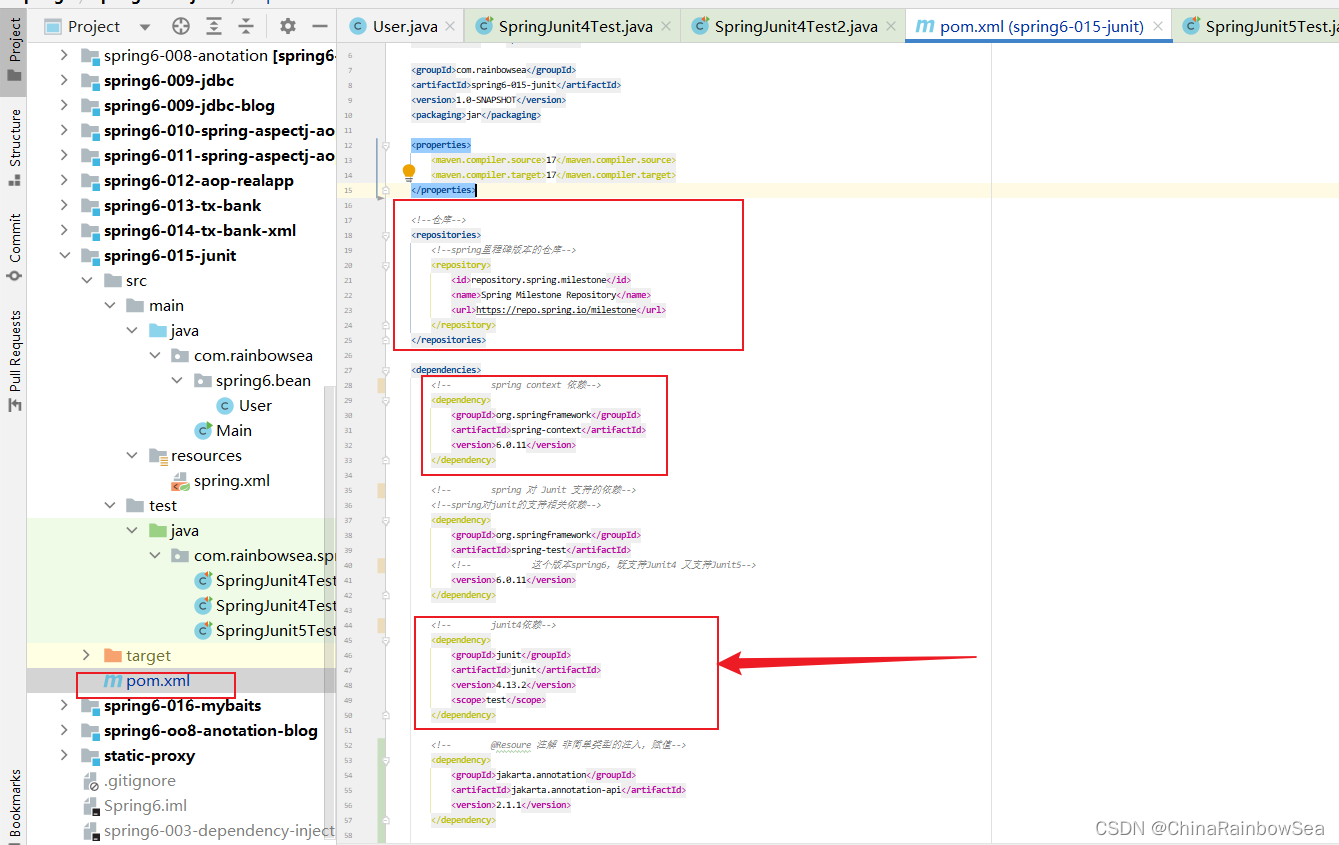
<?xml version="1.0" encoding="UTF-8"?>
<project xmlns="http://maven.apache.org/POM/4.0.0"xmlns:xsi="http://www.w3.org/2001/XMLSchema-instance"xsi:schemaLocation="http://maven.apache.org/POM/4.0.0 http://maven.apache.org/xsd/maven-4.0.0.xsd"><modelVersion>4.0.0</modelVersion><groupId>com.rainbowsea</groupId><artifactId>spring6-015-junit</artifactId><version>1.0-SNAPSHOT</version><packaging>jar</packaging><properties><maven.compiler.source>17</maven.compiler.source><maven.compiler.target>17</maven.compiler.target></properties><!--仓库--><repositories><!--spring里程碑版本的仓库--><repository><id>repository.spring.milestone</id><name>Spring Milestone Repository</name><url>https://repo.spring.io/milestone</url></repository></repositories><dependencies><!-- spring context 依赖--><dependency><groupId>org.springframework</groupId><artifactId>spring-context</artifactId><version>6.0.11</version></dependency><!-- spring 对 Junit 支持的依赖--><!--spring对junit的支持相关依赖--><dependency><groupId>org.springframework</groupId><artifactId>spring-test</artifactId><!-- 这个版本spring6,既支持Junit4 又支持Junit5--><version>6.0.11</version></dependency><!-- junit4依赖--><dependency><groupId>junit</groupId><artifactId>junit</artifactId><version>4.13.2</version><scope>test</scope></dependency><!-- @Resoure 注解 非简单类型的注入,赋值--><dependency><groupId>jakarta.annotation</groupId><artifactId>jakarta.annotation-api</artifactId><version>2.1.1</version></dependency></dependencies></project>
准备好,对于的 Bean 对象用于测试:注意:需要将其 Bean 对象纳入到 Spring IOC 容器当中进行管理上。
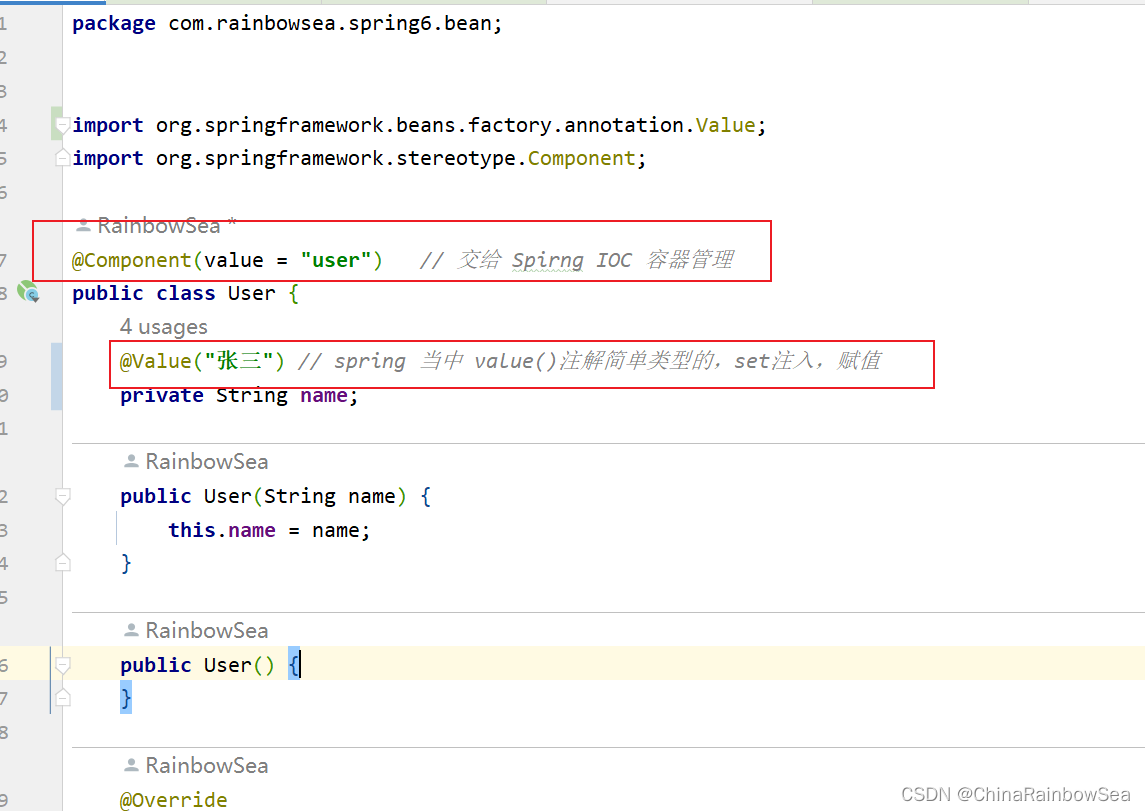
package com.rainbowsea.spring6.bean;import org.springframework.beans.factory.annotation.Value;
import org.springframework.stereotype.Component;@Component(value = "user") // 交给 Spirng IOC 容器管理
public class User {@Value("张三") // spring 当中 value()注解简单类型的,set注入,赋值private String name;public User(String name) {this.name = name;}public User() {}@Overridepublic String toString() {return "User{" +"name='" + name + '\'' +'}';}public String getName() {return name;}public void setName(String name) {this.name = name;}
}配置相关的:spring.xml 的配置信息的内容,这里我们用的是注解时开发,需要加上一个组件扫描 。
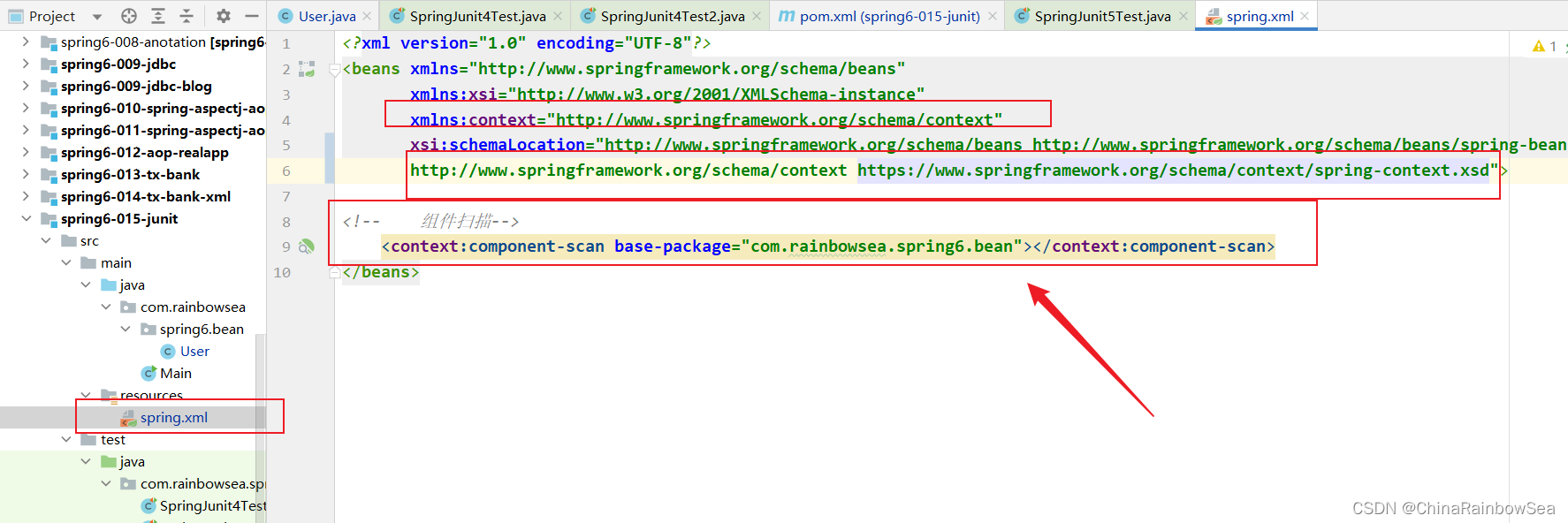
<?xml version="1.0" encoding="UTF-8"?>
<beans xmlns="http://www.springframework.org/schema/beans"xmlns:xsi="http://www.w3.org/2001/XMLSchema-instance"xmlns:context="http://www.springframework.org/schema/context"xsi:schemaLocation="http://www.springframework.org/schema/beans http://www.springframework.org/schema/beans/spring-beans.xsdhttp://www.springframework.org/schema/context https://www.springframework.org/schema/context/spring-context.xsd"><!-- 组件扫描--><context:component-scan base-package="com.rainbowsea.spring6.bean"></context:component-scan>
</beans>
单元测试:(一般平常的单元测试)如下:
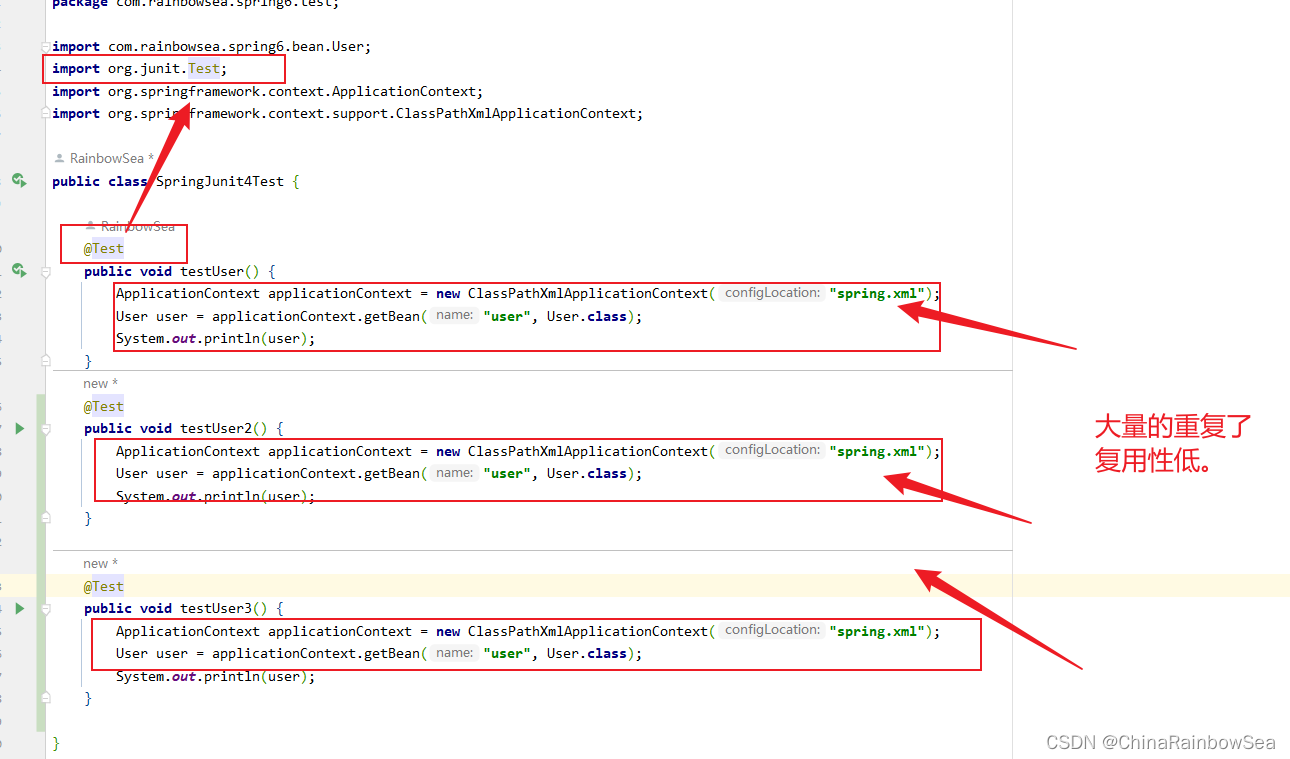
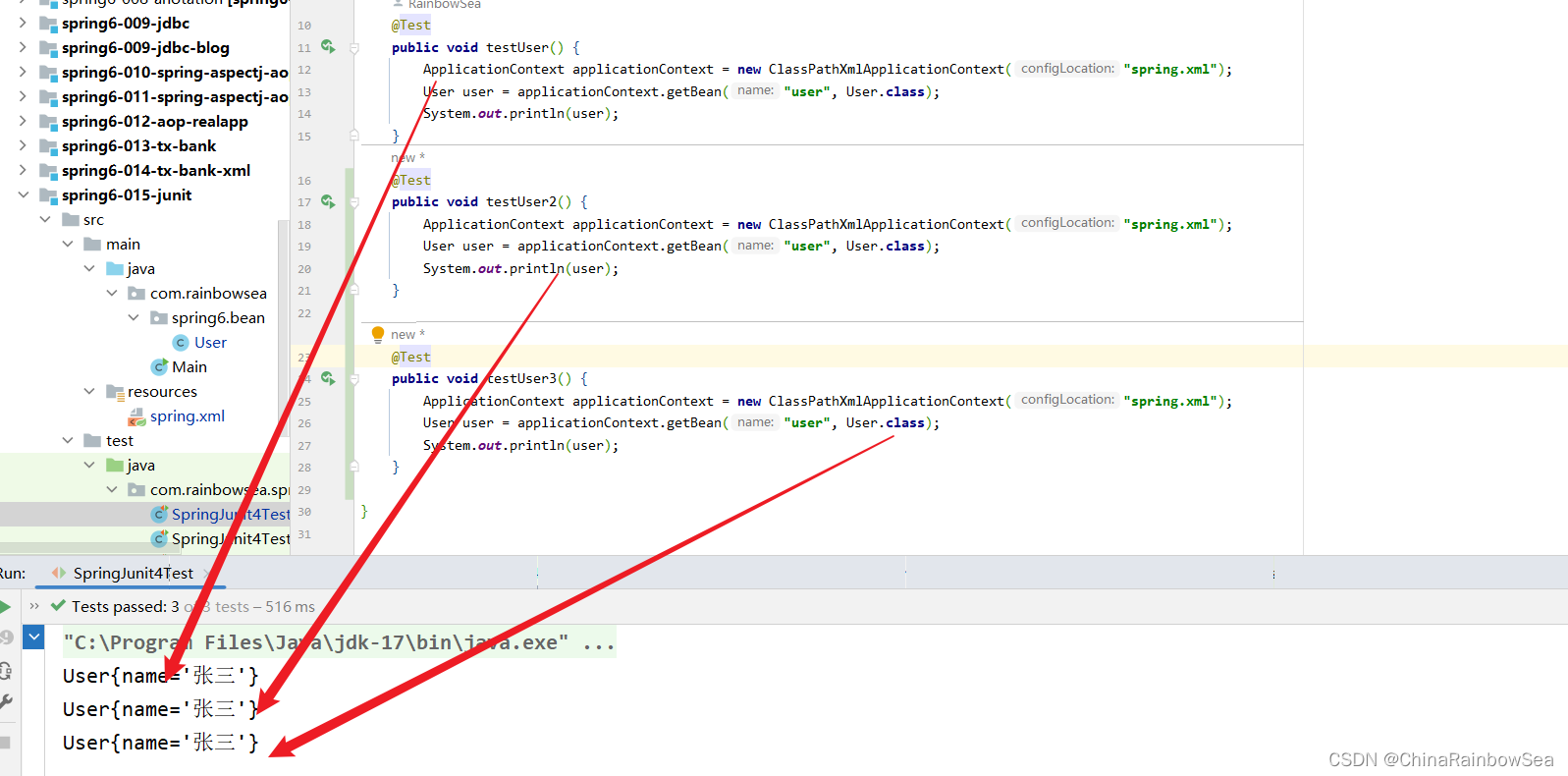
上述:方式,代码重复率高,复用性较差。
Spring提供的方便主要是这几个注解:
@RunWith(SpringJUnit4ClassRunner.class)
@ContextConfiguration(“classpath:spring.xml”)注意该:spring.xml 文件要一定要在类路径下才行 。
在单元测试类上使用这两个注解之后,在单元测试类中的属性上可以使用 @Autowired。比较方便。
@RunWith(SpringJUnit4ClassRunner.class)
@ContextConfiguration("classpath:spring.xml") // 注意该:spring.xml 文件要一定要在类路径下才行
优化如下:

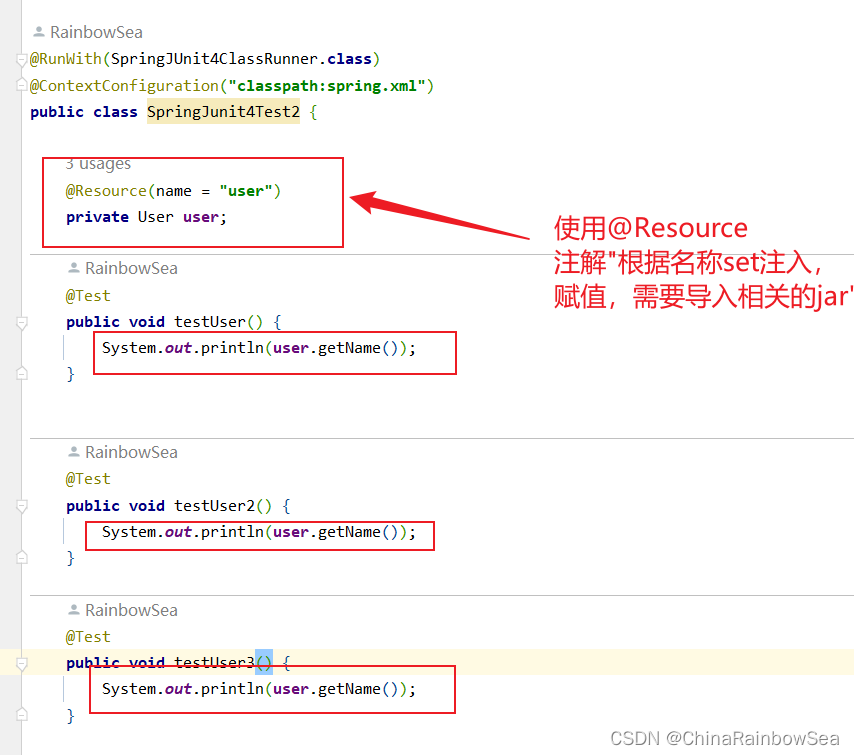
使用@Resource 需要导入相关的 jar 包,如下:

<!-- @Resoure 注解 非简单类型的注入,赋值--><dependency><groupId>jakarta.annotation</groupId><artifactId>jakarta.annotation-api</artifactId><version>2.1.1</version></dependency>
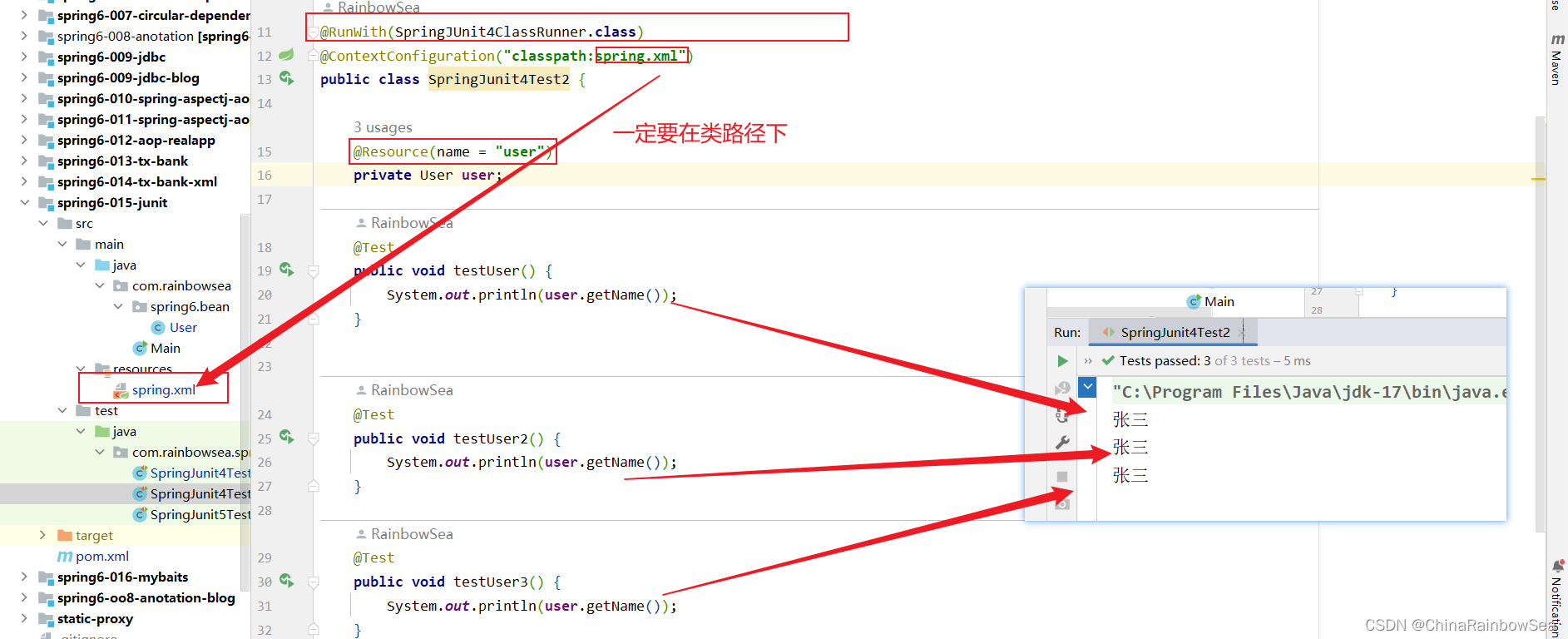
同时注意:该Juit4的@ Test 的注解是在:org.junit.Test; 包下的
package com.rainbowsea.spring6.test;import com.rainbowsea.spring6.bean.User;
import jakarta.annotation.Resource;
import org.junit.Test;
import org.junit.runner.RunWith;
import org.springframework.test.context.ContextConfiguration;
import org.springframework.test.context.junit4.SpringJUnit4ClassRunner;@RunWith(SpringJUnit4ClassRunner.class)
@ContextConfiguration("classpath:spring.xml")
public class SpringJunit4Test2 {@Resource(name = "user")private User user;@Testpublic void testUser() {System.out.println(user.getName());}@Testpublic void testUser2() {System.out.println(user.getName());}@Testpublic void testUser3() {System.out.println(user.getName());}}3. Spring对Junit5的支持
引入JUnit5的依赖,Spring对JUnit支持的依赖还是:spring-test,同时换成,junit5 ,还是在 pom.xml 文件当值配置相关依赖的 jar 如下:
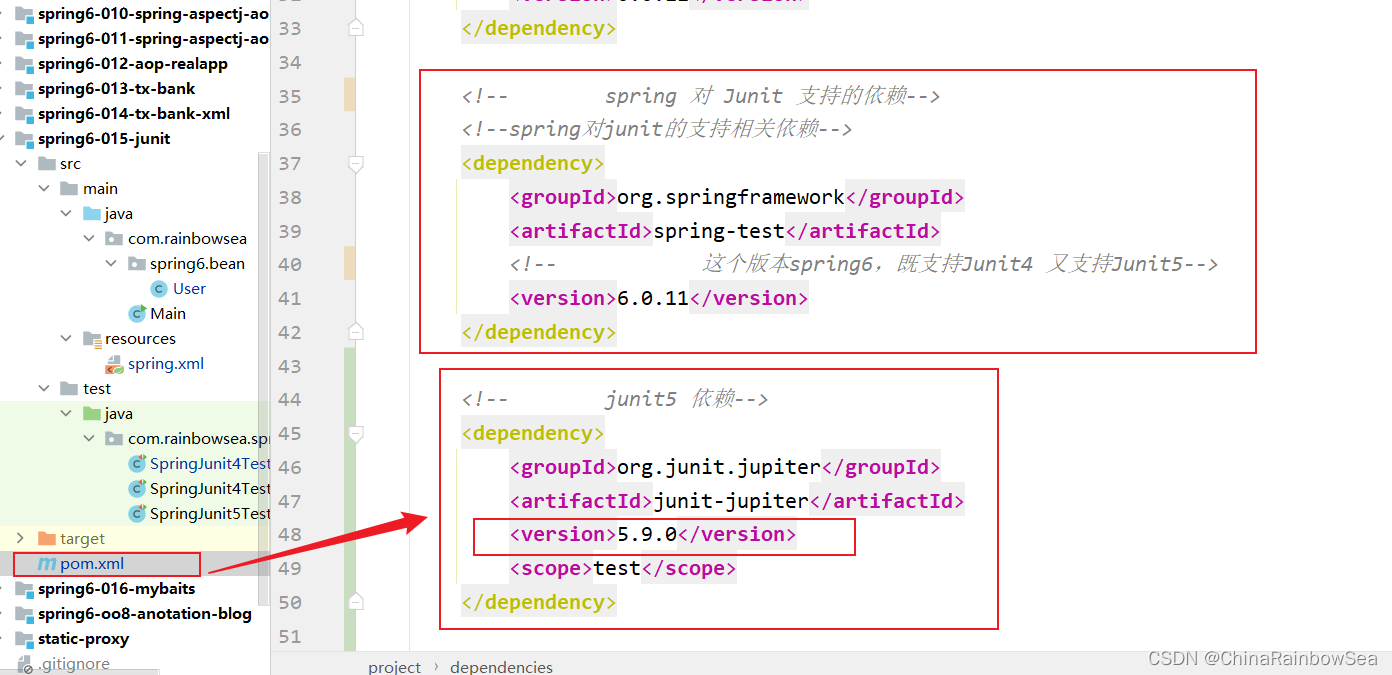
<!-- junit5 依赖--><dependency><groupId>org.junit.jupiter</groupId><artifactId>junit-jupiter</artifactId><version>5.9.0</version><scope>test</scope></dependency>
<?xml version="1.0" encoding="UTF-8"?>
<project xmlns="http://maven.apache.org/POM/4.0.0"xmlns:xsi="http://www.w3.org/2001/XMLSchema-instance"xsi:schemaLocation="http://maven.apache.org/POM/4.0.0 http://maven.apache.org/xsd/maven-4.0.0.xsd"><modelVersion>4.0.0</modelVersion><groupId>com.rainbowsea</groupId><artifactId>spring6-015-junit</artifactId><version>1.0-SNAPSHOT</version><packaging>jar</packaging><properties><maven.compiler.source>17</maven.compiler.source><maven.compiler.target>17</maven.compiler.target></properties><!--仓库--><repositories><!--spring里程碑版本的仓库--><repository><id>repository.spring.milestone</id><name>Spring Milestone Repository</name><url>https://repo.spring.io/milestone</url></repository></repositories><dependencies><!-- spring context 依赖--><dependency><groupId>org.springframework</groupId><artifactId>spring-context</artifactId><version>6.0.11</version></dependency><!-- spring 对 Junit 支持的依赖--><!--spring对junit的支持相关依赖--><dependency><groupId>org.springframework</groupId><artifactId>spring-test</artifactId><!-- 这个版本spring6,既支持Junit4 又支持Junit5--><version>6.0.11</version></dependency><!-- junit5 依赖--><dependency><groupId>org.junit.jupiter</groupId><artifactId>junit-jupiter</artifactId><version>5.9.0</version><scope>test</scope></dependency><!-- @Resoure 注解 非简单类型的注入,赋值--><dependency><groupId>jakarta.annotation</groupId><artifactId>jakarta.annotation-api</artifactId><version>2.1.1</version></dependency></dependencies></project>还是使用上面的 User 的 bean 对象进行测试:
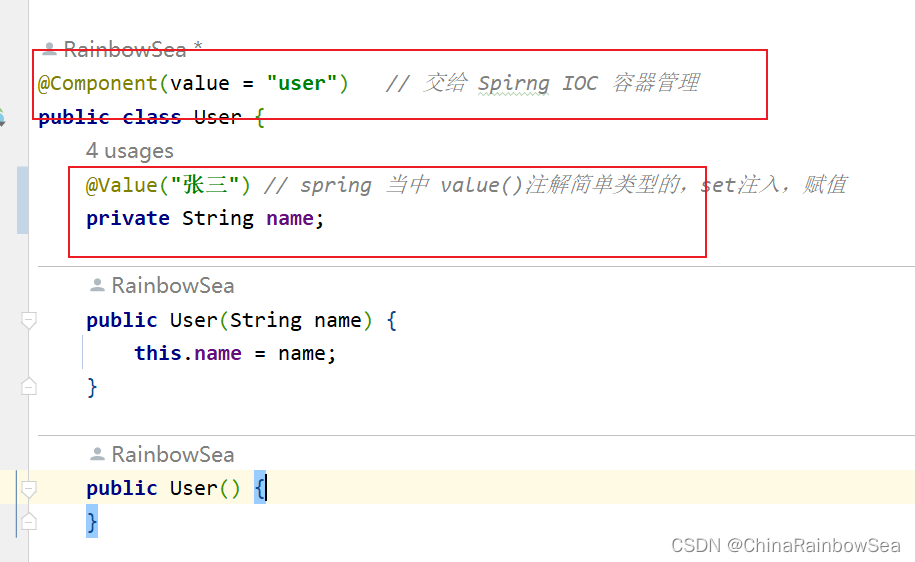
在JUnit5当中,可以使用Spring提供的以下两个注解,标注到单元测试类上,这样在类当中就可以使用@Autowired注解了。
@ExtendWith(SpringExtension.class) @ContextConfiguration("classpath:spring.xml") // 同样一定要是在类路径下@ContextConfiguration(“classpath:spring.xml”) // 同样一定要是在类路径下
同时注意:该Juit5 的@ Test 的注解是在:org.junit.jupiter.api.Test 包下的 ,选择的时候不要,弄错了。
单元测试:
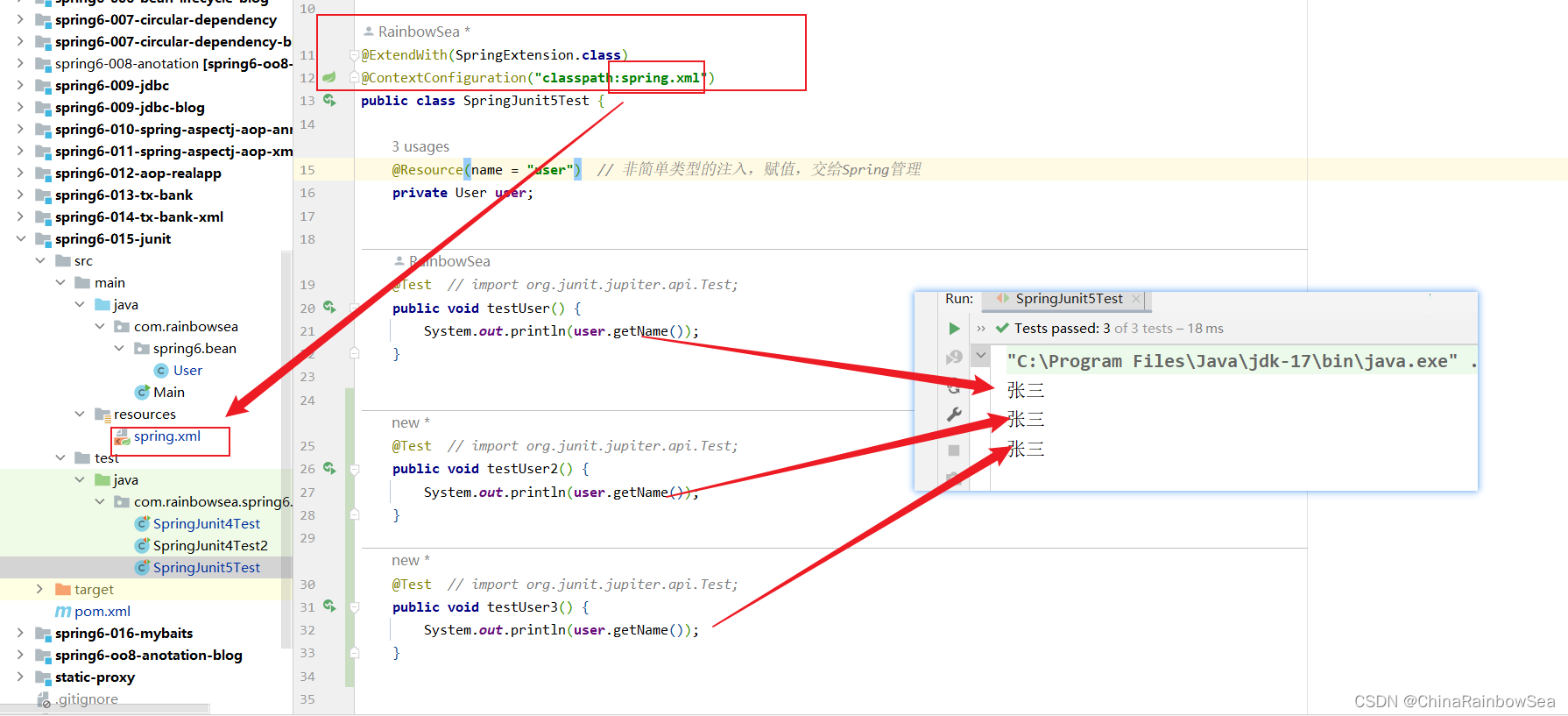
package com.rainbowsea.spring6.test;import com.rainbowsea.spring6.bean.User;
import jakarta.annotation.Resource;
import org.junit.jupiter.api.Test;
import org.junit.jupiter.api.extension.ExtendWith;
import org.springframework.test.context.ContextConfiguration;
import org.springframework.test.context.junit.jupiter.SpringExtension;@ExtendWith(SpringExtension.class)
@ContextConfiguration("classpath:spring.xml")
public class SpringJunit5Test {@Resource(name = "user") // 非简单类型的注入,赋值,交给Spring管理private User user;@Test // import org.junit.jupiter.api.Test;public void testUser() {System.out.println(user.getName());}@Test // import org.junit.jupiter.api.Test;public void testUser2() {System.out.println(user.getName());}@Test // import org.junit.jupiter.api.Test;public void testUser3() {System.out.println(user.getName());}}4. 总结:
- Spring 对 Junit4 的依赖的 jar 包,同时
@RunWith(SpringJUnit4ClassRunner.class) @ContextConfiguration("classpath:spring.xml") // 注意该:spring.xml 文件要一定要在类路径下才行
- 同时注意:该Juit4的@Test 的注解是在:org.junit.Test; 包下的
- Spring 对 Junit5 的依赖的 jar 包,同时
@ExtendWith(SpringExtension.class) @ContextConfiguration("classpath:spring.xml") // 同样一定要是在类路径下
- 无论是 Junit4 还是 Junit5 当中的 @ContextConfiguration 注解当中的 @ContextConfiguration(“classpath:spring.xml”) 都是:一定要是在类路径下才行的。
- 关于:Spring 对 Junit4,Junit5 的支持运用,大家灵活选择运用即可,并不是非要选择其中的哪个哪个啥的。满足业务即可。
5. 最后:
“在这个最后的篇章中,我要表达我对每一位读者的感激之情。你们的关注和回复是我创作的动力源泉,我从你们身上吸取了无尽的灵感与勇气。我会将你们的鼓励留在心底,继续在其他的领域奋斗。感谢你们,我们总会在某个时刻再次相遇。”


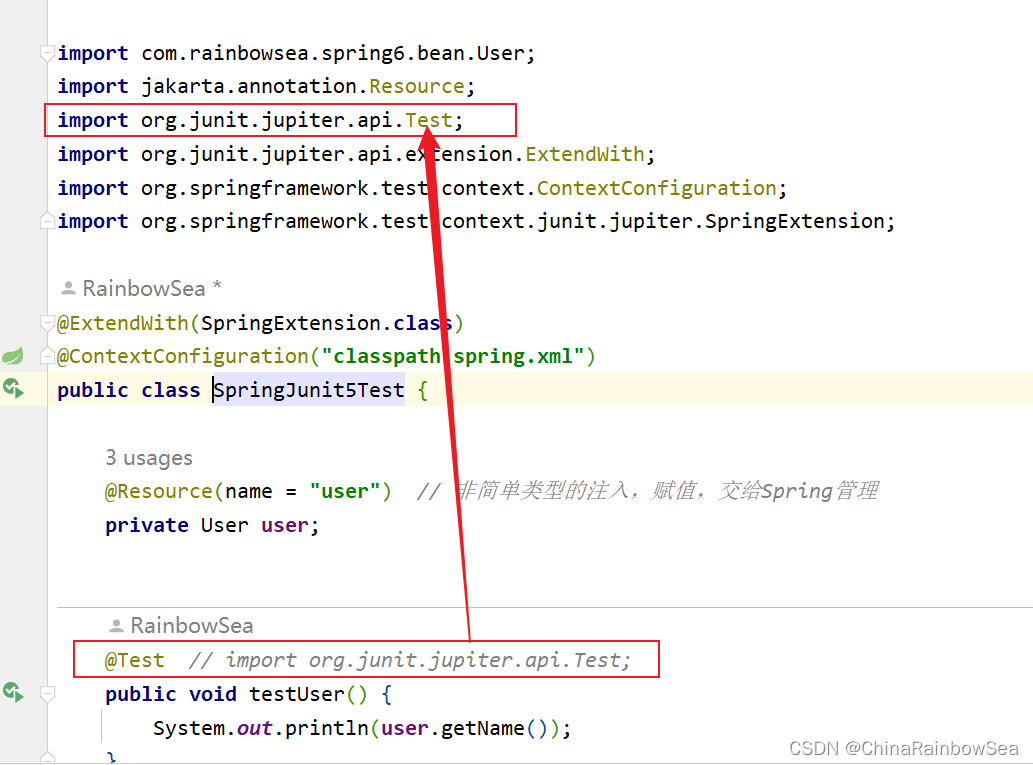

文件夹)





)
总数算不出+随机抽取10张)






)




